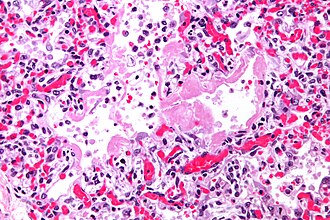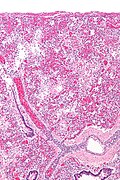Difference between revisions of "Diffuse alveolar damage"
Jump to navigation
Jump to search
(tweak) |
|||
| Line 37: | Line 37: | ||
*Abrupt hypoxemia with pulmonary infiltrates leading to epithelial cell and endothelial cell death not accompanied by cardiac failure.<ref name=Ref_PCPBoD8_364>{{Ref PCPBoD8|364}}</ref> | *Abrupt hypoxemia with pulmonary infiltrates leading to epithelial cell and endothelial cell death not accompanied by cardiac failure.<ref name=Ref_PCPBoD8_364>{{Ref PCPBoD8|364}}</ref> | ||
DAD is the histologic correlate of: | Classically, DAD is the histologic correlate of: | ||
*Acute respiratory distress syndrome (ARDS). | *Acute respiratory distress syndrome (ARDS). | ||
**[[AKA]] ''adult respiratory distress syndrome'' (ARDS) to differentiate it from ''[[respiratory distress syndrome]]'' in infants. | **[[AKA]] ''adult respiratory distress syndrome'' (ARDS) to differentiate it from ''[[respiratory distress syndrome]]'' in infants. | ||
| Line 50: | Line 50: | ||
*Idiopathic. | *Idiopathic. | ||
Notes: | |||
*DAD may ''not'' be present in all cases that are clinically ''ARDS''.<ref name=pmid23370917>{{cite journal |vauthors=Thille AW, Esteban A, Fernández-Segoviano P, Rodriguez JM, Aramburu JA, Peñuelas O, Cortés-Puch I, Cardinal-Fernández P, Lorente JA, Frutos-Vivar F |title=Comparison of the Berlin definition for acute respiratory distress syndrome with autopsy |journal=Am J Respir Crit Care Med |volume=187 |issue=7 |pages=761–7 |date=April 2013 |pmid=23370917 |doi=10.1164/rccm.201211-1981OC |url=}}</ref> | *DAD may ''not'' be present in all cases that are clinically ''ARDS''.<ref name=pmid23370917>{{cite journal |vauthors=Thille AW, Esteban A, Fernández-Segoviano P, Rodriguez JM, Aramburu JA, Peñuelas O, Cortés-Puch I, Cardinal-Fernández P, Lorente JA, Frutos-Vivar F |title=Comparison of the Berlin definition for acute respiratory distress syndrome with autopsy |journal=Am J Respir Crit Care Med |volume=187 |issue=7 |pages=761–7 |date=April 2013 |pmid=23370917 |doi=10.1164/rccm.201211-1981OC |url=}}</ref> | ||
*TRALI may have DAD; however, cases are reported without the pattern.<ref name=pmid18673344>{{cite journal |vauthors=Danielson C, Benjamin RJ, Mangano MM, Mills CJ, Waxman DA |title=Pulmonary pathology of rapidly fatal transfusion-related acute lung injury reveals minimal evidence of diffuse alveolar damage or alveolar granulocyte infiltration |journal=Transfusion |volume=48 |issue=11 |pages=2401–8 |date=November 2008 |pmid=18673344 |doi=10.1111/j.1537-2995.2008.01879.x |url=}}</ref> | |||
==Microscopic== | ==Microscopic== | ||
Revision as of 02:16, 19 July 2021
| Diffuse alveolar damage | |
|---|---|
| Diagnosis in short | |
 Hyaline membranes. H&E stain. | |
|
| |
| LM | dependent on phase - exudative: hyaline membranes; proliferative: interstitial thickening, inflammation (lymphocytes), type 2 pneumocyte hyperplasia, edema, Masson bodies in the airway, hyaline material (usu. focal); fibrotic: interstitial inflammation, interstitial fibrosis |
| Subtypes | exudative, proliferative, fibrotic |
| LM DDx | organizing pneumonia (especially for proliferative phase DAD), bronchiolitis obliterans |
| Site | lung - see diffuse lung diseases |
|
| |
| Prognosis | often poor, dependent on severity and comorbidities |
| Other | histologic correlate of: acute respiratory distress syndrome (ARDS), acute interstitial pneumonia (AIP), transfusion related acute lung injury (TRALI) |
| Treatment | dependent on underlying cause |
Diffuse alveolar damage, abbreviated DAD, is a relatively common lung pathology that is grouped with the diffuse lung diseases and has several clinical correlates.
General
Etiology:
- Abrupt hypoxemia with pulmonary infiltrates leading to epithelial cell and endothelial cell death not accompanied by cardiac failure.[1]
Classically, DAD is the histologic correlate of:
- Acute respiratory distress syndrome (ARDS).
- AKA adult respiratory distress syndrome (ARDS) to differentiate it from respiratory distress syndrome in infants.
- Acute interstitial pneumonia (AIP).
The DDx is broad:[2]
- Infection/sepsis.
- Toxic (smoke, oxygen).
- Drug (amiodarone, chemotherapy).
- Trauma/shock.
- Inflammatory.
- Idiopathic.
Notes:
- DAD may not be present in all cases that are clinically ARDS.[3]
- TRALI may have DAD; however, cases are reported without the pattern.[4]
Microscopic
- Exudative:
- Hyaline membranes - key feature.
- Debris (pink crap) lines the alveolar spaces.
- Hyaline membranes - key feature.
- Proliferative:
- Interstitial thickening.
- Inflammation (lymphocytes).
- Hobnailing of alveolar lining cells (type 2 pneumocyte hyperplasia[7]).
- Edema (link pink crap in the alveoli).
- Masson bodies in the airway.
- Hyaline material (usu. focal) - key feature.
- Fibrotic:
- Interstitial inflammation.
- Fibrosis.
DDx:[6]
- Cryptogenic organizing pneumonia - especially for proliferative phase DAD.
- Bronchiolitis obliterans.
Images
www:
- Proliferative phase DAD - intermed. mag. (flickr.com/Yale Rosen).
- Proliferative phase DAD - high mag. (flickr.com/Yale Rosen).
See also
References
- ↑ Mitchell, Richard; Kumar, Vinay; Fausto, Nelson; Abbas, Abul K.; Aster, Jon (2011). Pocket Companion to Robbins & Cotran Pathologic Basis of Disease (8th ed.). Elsevier Saunders. pp. 364. ISBN 978-1416054542.
- ↑ Humphrey, Peter A; Dehner, Louis P; Pfeifer, John D (2008). The Washington Manual of Surgical Pathology (1st ed.). Lippincott Williams & Wilkins. pp. 91. ISBN 978-0781765275.
- ↑ "Comparison of the Berlin definition for acute respiratory distress syndrome with autopsy". Am J Respir Crit Care Med 187 (7): 761–7. April 2013. doi:10.1164/rccm.201211-1981OC. PMID 23370917.
- ↑ "Pulmonary pathology of rapidly fatal transfusion-related acute lung injury reveals minimal evidence of diffuse alveolar damage or alveolar granulocyte infiltration". Transfusion 48 (11): 2401–8. November 2008. doi:10.1111/j.1537-2995.2008.01879.x. PMID 18673344.
- ↑ Klatt, Edward C. (2006). Robbins and Cotran Atlas of Pathology (1st ed.). Saunders. pp. 103. ISBN 978-1416002741.
- ↑ 6.0 6.1 Castro, CY. (2006). "ARDS and diffuse alveolar damage: a pathologist's perspective.". Semin Thorac Cardiovasc Surg 18 (1): 13-9. doi:10.1053/j.semtcvs.2006.02.001. PMID 16766248.
- ↑ URL: http://d3jonline.tripod.com/20-Pulmonary_II/Pathology_of_Interstitial_Lung_Diseases.htm. Accessed on: 22 February 2012.




